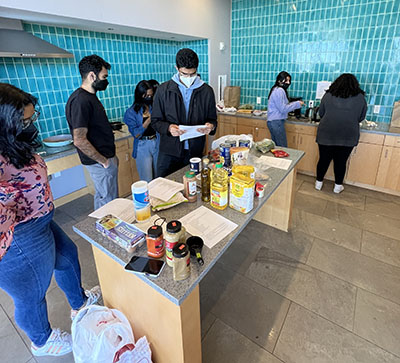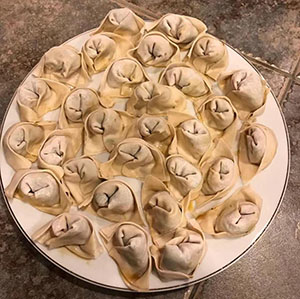3 student shared recipes for Asian American Pacific Islander Heritage Month
Trying different cuisines from around the world can be a great way to learn more about different cultures. For Asian American Pacific Islander Heritage Month, members of different campus organizations from the ICC shared their favorite dishes that represent their culture.
It can be intimidating to create an unfamiliar recipe from scratch, but the Vietnamese Student Association, Chinese Cultural Connection and South Asian Student Association provided recipes that have flexible ingredients, quick cook times and can be created in a residence hall kitchen with common cooking tools.

Students posed at a recent Vietnamese Student Association event
Create your own spring rolls with the Vietnamese Student Association
As the outreach chair of the Vietnamese Student Association, Nhi Tran ‘23 enjoys the community atmosphere of the organization. “Coming to Brandeis from Texas, it was important for me to find my culture on campus,” said Tran. “The Vietnamese Student Association has become my home away from home.”
When asked to provide a recipe, VSA selected Vietnamese summer rolls, a favorite among group members. Unlike spring rolls, which are wrapped in flour and fried, summer rolls are made using fresh rice paper and served cold.
“If your dorm has a kitchen, spring rolls are so easy to make,” said Tran. Tran provided a Vietnamese Summer Roll recipe for reference from the New York Times, but if you don’t have the exact ingredients, don’t worry..
“You don’t even have to stick to the recipe,” she said.
These rolls can work with many of your favorite vegetables, noodles and proteins. However, the sauce accompanying the rolls is non-negotiable. There are numerous sauces that are commonly used, such as the garlic fish sauce mentioned in this NYT recipe, but Tran recommends creating a peanut sauce with peanut butter, hoisin, and water. “The sauce pulls everything together,” said Tran.

Students create a dish together at a recent event.
Mix up your breakfast with Batata Poha from the South Asian Student Association
Jigar Gohel ‘23 enjoys being a member of the South Asian Student Association because it’s given him the opportunity to meet people with a lot in common, but at the same time, so many differences.
“I relate to them because we all have a similar background, but everyone is from different areas of South Asia,” said Gohel. “I’ve met a lot of my closest friends through the group.”
Gohel shared a recipe for Batata Poha from Tarladalal, an Indian dish his mother made for him growing up. “We’d have it every once in a while for breakfast as a special treat,” he said. It’s an Indian breakfast staple, featuring flaky rice, potatoes and a variety of spices. Gohel remembers his mom creating different versions by switching up the ingredients.
There are many variations to this meal, but Gohel explained that it should be easy to recreate.
“I’m not a good cook and I can definitely recreate this dish,” he said.

Ren created homemade dumplings of her own.
Discover different dumplings with the Chinese Cultural Connection
“Chinese culture is portrayed in a specific way in the media,” said Scarlett Ren ‘24, a member of the Chinese Cultural Connection. “Our group tells the bigger story. I enjoy that we get to share our culture with the Brandeis community.”
Ren shared a Chinese dumpling recipe, Homemade Dumplings from Tasty, along with the symbolism of the dish. “Dumplings symbolize unions and gatherings,” said Ren. “They’re a way to get together with people to enjoy food.” The recipe shared may have a list of steps, but it’s completely doable in a resident hall kitchen.
While people use the term ‘dumplings’ freely, there are numerous variations. This depends on geographic location, family traditions, and other factors. However, all dumplings are generally a form of dough filled with different mixtures that are either fried or steamed. The biggest factor is the formation of the dumpling.
“Depending on where you’re from in China, they’re made differently,” said Ren. “It all comes down to how you fold them.”Categories: General, Student Life





